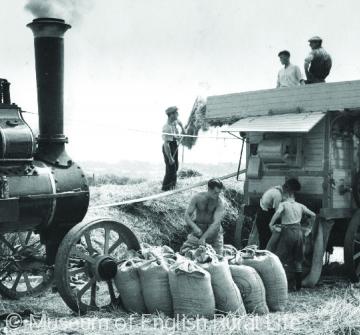High Farming
 A Fowler steam plough, shown here powering a mobile threshing machine.
A Fowler steam plough, shown here powering a mobile threshing machine.The term ‘High Farming’ was applied to virtually any type of good quality farming – as judged to be the case by contemporary expert commentators. Low farming was traditional farming by unimproved methods so that High Farming was, by contrast, good quality farming achieved by using the most efficient methods, the best rotations, the best seeds, the best fertilisers, and by the way in which the land was organised. Contemporaries had no specific definition, but they clearly knew what they meant.
Farmers and landowners who under-drained their land, who introduced new and innovative crop rotations, who maximised use of their land without exhausting it, and who introduced the most up to date ways of fertilising their land, were the high farmers, while those who still followed the older methods were low farmers. Sometimes known as the Golden Age, the 1850s and 1860s were the heyday of high farming, and saw rising output and with it profits for farmers, despite the repeal of the Corn laws in 1846, which had widely been regarded as shielding the farmer from the full impact of market forces.
In the mid-1870s, and through the 1880s and beyond, the impact of market forces became clearer, particularly with the import of north American grain and refrigerated meat from South America. The Golden Age was followed by a Great Depression, which saw rents and land values falling, farmers forced from the land, and the laying down to permanent grass of much arable land which was marginal in productivity terms. Recovery occurred only after 1947.








